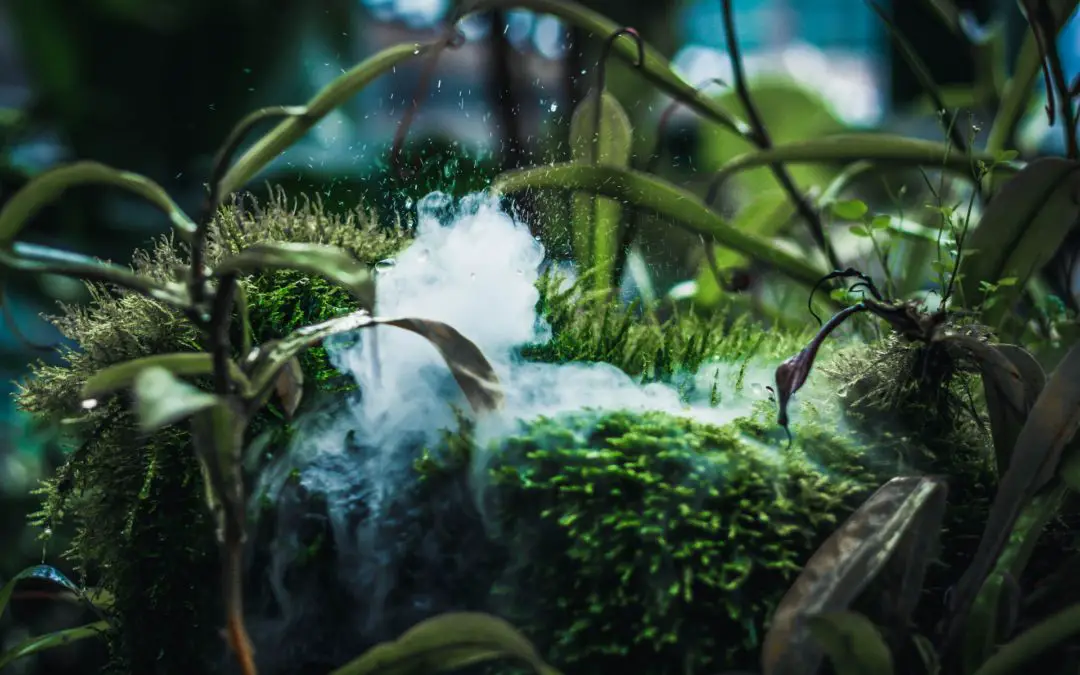What is a biowall?
A biowall is another name for a living wall, they often also incorporate a forced air system. Air can be blown or sucked through a living wall so it has higher contact with air and more humidification.
How much does soil weigh?
Soil weighs around:
- Wet soil: 3000 lbs per cubic yard or around 74 lbs per cubic foot
- Dry soil: 2000 lbs per cubic yard 110lbs per cubic foot
But this can vary depending on organic content, sand content, compaction, and many other factors.
Do living walls destroy the wall (especially drywall) behind?
It depends how you build them. If you take a permeable living wall system built for outdoor use, and install it inside without a waterproof backer, it can definitely damage your wall. The important thing is to have a capillary break (prevent wicking), and ideally an air gap so no moisture builds up on the wall behind. Another method is to design the wall behind to be waterproof, much like a shower.
Which name is more common: living wall, green wall, biowall or plant wall?
One way to figure this out is to look at google trends. It’s hard to tell what the intent of the keyword phrase is. For example someone could be searching for a living plant wall when they type in “green wall”, or they might be interested in painting their wall green.
In order of Highest interest to lowest interest (searches):
Living wall (highest), green wall and plant wall (medium), and biowall (low).

Do living walls encourage mold?
If you have healthy soil and healthy plants, you shouldn’t have any mold problems. Walls can become moldy if there’s insufficient waterproofing and no air gap between the living wall and drywall.
What is the great green wall?
Well, it’s a different type of green wall than we’re usually talking about here. China’s building a giant band of trees to prevent expansion of deserts (desertification).
It’s an incredibly ambitious project that could have huge ramifications.
Officially called the Three-North Shelter Forest Program, it’s a series of shelterbelts (wind-breaks made up of trees) designed to slow or stop the spread of the Gobi desert and create harvestable timber resources for locals.
The new leaves on my variegated plant are green, why?
Variegation is often a mutation of green plants. Variegation is a good indicator of whether a plant is receiving the right lighting intensity – or not! The lighter colored parts of variegated leaves have less chlorophyll, which plants use to convert light energy into chemical energy in sugars. When the plant isn’t receiving enough light, it needs more chlorophyll to compensate. Chlorophyll is green, so your plant makes greener leaves. Moving the plant to an area with more light, or adding some artificial light should bring back the variegation.
Can I use a desk lamp for my plants?
Using a desk lamp as a grow lamp is a great option to give them more light intensity. If you have a spot with less light, maybe it’s away from a window, but you still want plants there, consider a desk lamp. But not just any lamp or bulb will do. A normal incandescent or energy saving bulb might not have the right spectrum.
For more info, I wrote an article specifically on grow lights for tropical living plant walls. If you don’t have enough natural light, there are still a lot of options.
What’s the easiest way to pick plants for my living wall?
Get a diverse selection that roughly matches your environment, for example tropicals indoors., Give them the best chance you can, then see which plants die and which thrive. Add more of what thrives.
How do I mount a living wall frame?
A living wall frame is a planter that’s waterproof so it won’t damage your wall. Wet soil can be heavy so mount your living wall frame to the studs in your wall. Ensure there’s no moisture transfer between your planter and your wall, make sure it’s properly waterproof, and there are no capillary pathways (porous material, fabric etc) that connect the planter to the wall.
Are living walls high maintenance?
Not if you set them up right. Choose resilient, low maintenance plants like Golden Pothos. With enough growing medium, soil for example, your wall can hold moisture for extended periods, requiring watering every 3 weeks or longer. If you want even lower maintenance use sub-irrigation. With sub-irrigation there are no moving parts, and the plants draw moisture from a reservoir by capillary action.
Living wall maintenance depends on how well matched your plants are to the environment. Lighting, moisture, and temperature need to be matched to your plants’ needs. Put succulents in higher light intensity and dryer environments. Tropical plants prefer more moisture (although the most common cause of death is over-watering) and more light intensity.
The expansion of living wall installations in recent years is evidence for the low-maintenance nature. The technology and plants used in designs have evolved over the years to offer very low maintenance options.
Do living walls cause bug infestations?
A lot of people are worried that living walls with be breeding grounds for bugs.
The most important factor in resisting bugs is plant health. Healthy plants have natural defenses against insects. Don’t over-water. Root rot and other over-watering related diseases weaken plants, which gives them an edge.
Carefully inspect any new plants before introducing them to a living wall.
Do living walls cause moisture problems?
Living walls can cause moisture problems if they’re not designed properly. There must be a moisture barrier between the wall and the building. Ideally the growing medium has a waterproof backing, and there’s an air gap between it an the wall. Alternatively the living wall can be installed in a waterproof location, much like a shower.
Can ferns grow on a living wall?
Ferns do well on living walls as long as. they have enough moisture and humidity. Sword fern and birdsnest ferns typically fare a little better. Avoid maidenhair ferns unless you have high humidity levels.
Here are 25 ways you can increase humidity for plants if you’re looking for some options!
When should I remove a plant from a living wall?
You can remove plants from the wall for a few reasons:
- You want a new look, cycling plants can be a great way to keep your wall exciting and healthy.
- Plants are declining or dead. Dying plants should be removed so they don’t spread decomposing micro-organisms to other plants.
- Plants are overgrown and out-competing nearby plants.
How do you have hanging plants without saucers?
If pots have no holes for drainage you need to be very careful not to overwater them. Have the right kinds of plants and the right kinds of soil. Select plants that prefer a moister soil. Moisture tolerant soils. If using a pot with no drainage holes and no saucers, select a pot made from a porous material like unglazed clay.
What are good pot setups for hanging plants?
Hang a wicker basket with a bag in it. Put some stones in the bottom of the bag. The bag contains any extra water. The pebbles raise the soil out of the water so it doesn’t become stagnant. Smell can be a good indicator of problems. It should smell earthy, not rotten.
How do you dust plants?
When plants have dust buildup less light makes it to the leaves. It’s important to dust plants so they do as well as possible. A damp cloth, towel or sponge works great. Go leaf by leaf. There’s no real shortcut. You can use a spray bottle to mist the plants, or spray with a hose, but this will introduce a lot of water to the soil, so don’t rely on this.
In terms of preventing dust buildup, sweep or vacuum a little more often, and change your furnace filters at least every 6 months.
What are good plants for small apartments?
Small apartment plants might be limited on space, but this often means limited on light too. Great plants for a small apartment are:
- Epipremnum Aureaum (golden pothos), hoya,
- Chlorophytum Comosum (spider plant)
- Sansevieria Trifasciata (snake plants)
- Succulents (Aloe vera or otherwise! If you have lots of light)
- Zamioculcas Zamiifolia (ZZ plant)
If you’re very limited on space, a small living wall or vertical garden can be a great idea. Or you can hang plants on the wall or on shelves.
Why is my tropical plants blooming?
It depends on what type of plant it is. Some plants bloom when they’re stressed. Some tropical plant will bloom if conditions aren’t perfect. This could be too little water, too much or not enough light, or other causes. It can be tricky to pin down.
Other plants bloom when they’re not stressed as well. But overall, it’s a sign that your plant is healthy enough to create flowers.
How to repot a huge houseplant
Remove as much soil around the top of the plant as possible. Tilt the plant on its side and ease the plant out of the pot. If it’s really stuck you can try wetting the root ball to soften the soil.
Once the plant is separated, see if the plant can be divided. This will depend on the type of plant. You may be able to tease and work the roots apart so you can repot the multiple plants individually.
When repotting it’s good to repot with a portion of the old soil. The plant will be used to working with the micro-biome in the old soil, and it will shock the plant less as it adapts. Mix the old soil with the new soil in the pot. Plant the plant at approximately the same depth as it was at before. You don’t want the plant to be much deeper or shallower in the soil or it can cause problems.
You want to compact the soil so the plant doesn’t move too much when watering. Plant movement can damage small roots. Give the plant a good watering after repotting.
How do living walls mimic nature?
Biomimicry is increasingly used in architecture and interior design. The idea is to emulates plants living in nature on a rock face or in trees. Epiphytes are plants that grow above the forest floor, on another plant, a tree, or sometimes on cliff sides! Horticultural awareness of the plant combinations and inter-relationships is important.
Since many plants grow on vertical surfaces, the plants are in a more natural environment. Vertical surfaces can have better airflow, better light exposure, and better drainage than horizontal.
How long does it take a living wall to grow in?
Living walls can be designed to be fully (more or less) flushed out from the start, or with a little grow-in period. For new construction that will be vacant for a few weeks or months, walls can be planted with smaller younger plants. Plants can have an adaption period and lose some folliage, so be aware of that.
It’s hard to put numbers on it, but most walls will be fully established in 1-2 months.
What does my architect need to know to design around a living wall?
Architects are concerned with how and why to design with the constraints of the client. They’re concertned about design, but also more practical aspects like privacy, lighting, wind, structure, and electrical and mechanical systems. Your architect should coordinate with the living wall designer to lock in a few key aspects of the wall design:
- What are the focal points? Where are the accent plants?
- How will the lighting be handled? What will the combination of natural and artificial lighting require?
- What will the key textural and color variations across the wall be?
- How will the wall work within the space to respect outside views, dimmer evening lighting, and the occupant’s preferences.
The greatest reward for an architect is to create a beautiful functional space for you that people want to visit again and again.
How architects use the sun to influence their design
One of the most important things architects do is listen, and not just to the client! They look to the the site, the climate, the geography, the wind patterns and the sun. In general, when architects are considering sunlight in their design, they’re playing with how the light can be:
- Absorbed
- Blocked
- Filtered
- Consumed
- Stored
- Reflected
There are a number of tools at their disposal:
- Overhangs
- Sunshades
- Awnings
- Screens
- Louvers
- Brise Soleil
Many of these can incorporating living plant elements, including living walls. This can add incredible seasonal variation. In climates will colder winters, this can for example be used to filter light in the summer through leaves, and allow fun sunlight penetration in the cold of winter. The best of both worlds.
A good architect will track the solar orientation throughout the year (using software). Where does the most direct sunlight come from? How can solar resources be incorporated into the design? What’s the optimal balance between optimal natural light, privacy, views, and functionality?
Too much sun can overheat spaces and make them uncomfortable. Horizontal elements can save southern elevations from overheating. High angle sun causes overheating. Low angle sun is great in the winter.

I’m Alex Lafreniere. I learned a lot about plants when I built and operated a landscaping company. But, there’s always more to learn. Ever since travelling across the world, I’ve wanted to find ways to bring more tropical and exotic plants into my life. This is the site where I share everything I’ve learned with you.
This site is owned and operated by Plant Hardware, a sole proprietor headquartered in Calgary, Canada. Plant Hardware is a participant in the Amazon Services LLC Associates Program, an affiliate advertising program designed to provide a means for sites to earn advertising fees by advertising and linking to Amazon.com.Plant Hardware may also participate in affiliate programs with Bluehost, Clickbank, CJ, ShareASale, and other sites. Plant Hardware is compensated for referring traffic and business to these companies.

